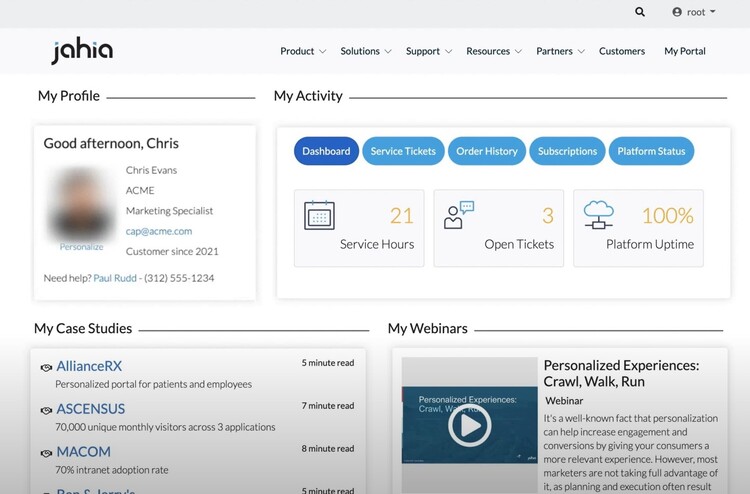The Importance of Flexibility Across your Application Ecosystem

The three degrees of flexibility you should consider when evaluating digital service platforms
The digital renaissance is in full swing across the business realm; no matter if you’re in government, healthcare, finance or any other specialized industry — the expectation is that you’ll be providing an engaging digital service, one that can cater to a broad spectrum of user processes and workflows.
Digital doesn’t just mean launching a single webpage backed by a database and calling it a patient portal, or a collection of interlinked pages and labelling it an employee intranet; digital now represents omni-channel, authenticated experiences.
The demand for increasingly sophisticated solutions continues to grow as technology stacks begin to encompass a wider array of business functionalities — each of which capture their own sets of data, and all of which represent value to the other components of an application ecosystem.
As such, when deciding on a solution to provide authenticated experiences like intranets and web portals, it pays to take into account the flexibility of a system and the varying ways it can interact with the rest of your technological architecture.
We’ve broken this flexibility into three degrees of complexity, all of which we firmly believe you should take into account when defining your digital strategy.
First Degree: Development Flexibility
Whether you’re building a best-of-breed technology stack or buying a jack-of-all-trades application suite, there needs to be flexibility in the core architecture — enough to allow you to build out your technological capabilities independent of any vendor.

The entire buying process should be geared towards ensuring you have your baseline requirements met — but in the fast-paced world of digital, functional necessities from a technical solution can be more fluid than you realize. Failing to take this into account can result in a rigid system that gives you little choice but to either see out the implementation lifecycle, all the while watching your competitors overtake you with more adaptable software solutions, or be held to ransom by a vendor if you’re required to make hard changes to a solution in order to accommodate an unforeseen process.
In this scenario, the stack approach definitely shines; stack applications, by design, have interoperability at their core. Vendors who move in this space understand the need to link applications and extend functionalities; they’ll have a wide variety of APIs or toolset to support developers, with all the supplementary documentation. Suites on the other hand, have a vested interest in keeping the garden very much walled; you can get locked in, with little room to maneuver — especially if the suite is responsible for a large part of your LOB processes. It’s something to consider.

At Jahia, we back the stack — so it’ll come as no surprise that our Digital Experience Platform (DXP) is built on a modular architecture, OSGI, that allows you to seamlessly develop and deploy new functionalities. We call these ‘modules’ and their capabilities can range from the simple to comprehensive; this could mean creating a custom blogging tool, or developing a new function with a much broader scale that leverage APIs and multiple code bases — jExperience, our personalization and analytical tracking tool, was actually built in this way.
OSGi also allows you to ‘hot deploy’ these modules, which means you don’t have to take your instance offline to get a new feature to start working — they’re one-click activated. Before you start developing though, make sure to check the Jahia store — there’s more than one-hundred extensions already available.
Development is an incredibly powerful degree of flexibility, but it might not be the most important — it depends on your business. In a perfect world, it essentially represents a blank cheque; with enough developers & time, you can achieve anything.
Second Degree: Integration Flexibility
Alas, we don’t live in a perfect world — and you might only have one developer who has a couple of weeks to integrate an entire business process across your solution architecture. If this is the case, then our second degree of flexibility, integration, might be more relevant.

Once again leveraging the Stack/Suite dynamic — whichever approach you’ve adopted to build out your technology ecosystem, you’re going to have a diverse set of applications. Each one is going to generate their own data and contain valuable processes that could benefit the rest of the stack as a whole. The trouble is, you don’t always have the resource or time to effectively leverage things like APIs or dev-kits in order to integrate a process into another application. In this scenario, it pays to have a solution which provides a quick work-around, such as the ability for one application to ‘embed’ the process of another, without actually having to execute the process natively.
This is what we mean when we say Integration Flexibility; being able to leverage the benefits of an existing application without having to do the heavy lifting of hard-coding it into your solution.
The suite approach comes out on top here; as it should. The whole point of a suite is to have native interoperability with the rest of its first-party application ecosystem. If a suite solution struggles with this — start running.
Don’t discount the stack approach though; stackable apps have an inherent need for connect-ability, so a lot of them have just the tools for a wily enterprise.

For example, Jahia leverages the ESI-Gate framework — a server-side integration tool which allows the seamless combination of web applications, so you can embed third-party processes from an ERP, HCM, CRM, etc. within an authenticated web portal experience.
We also provide a tool called the External Data Provider; this allows you to mount external data repositories directly into our asset manager, where you can treat them as first-party Jahia content — with the flexibility to reflect real-time updates or utilize a cache system.
The ideal scenario is to develop first party process integrations between applications — but in reality, this isn’t always possible. Taking into account Integration Flexibility means that you can start realizing value from your wider application ecosystem much more quickly. hopefully we’re not selling this approach short — we have a few customers who leverage ESI-Gate in their production instances. But equally, this approach can represent a stepping stone, at least until you have enough breathing room to devote the appropriate resources towards building a more well-rounded connector.
Third Degree: Data Flexibility
For this final degree of flexibility, we can shed the stack/suite paradigm. Why? Because if an application doesn’t accommodate data flexibility in the current tech climate, well then they’re probably not long for this world — at least as a viable, competitive solution.

The data gold-rush is well and truly underway; I don’t need to sit here and type out another think-piece on how data is revolutionizing literally every industry — chances are, you probably know that already.
As such this might be obvious, but i’ll spell it out anyway — the absolute bare minimum a modern solution should offer in regards to flexibility, is the ability to easily import/export data between applications. API-first is the name of the game and we’ll begrudgingly accept an automated excel export/import.
But to really compete, you need to choose a solution which treats data as a core component. This doesn’t necessarily mean it needs to track every single user event or click; more isn’t necessarily merrier in the world of data. But it is important that it collects the data points which are most valuable to your business — both from an operational standpoint, and in regards to improving customer experience. In addition, your solution needs to make this data readily accessible to your wider ecosystem from a push and pull perspective.
Here’s a scenario: say a web portal user indicates that they want to see more video resources on their homepage. This could be valuable information to a Sales Rep — even so, Sales Reps aren’t going to be spending their time browsing individual user settings for such data; it’s not efficient. But if this data were to, say, automatically transfer to the CRM, well then the ASR could reach out to this user in order to pinpoint exactly what they’re interested in. They could then record this data which would get automatically pushed back from the CRM to the users portal, which can in turn promote access to resources for new products, providing a passive up-sell opportunity.

Scenarios such as this are a win-win — but more importantly, they utilize your data as a tool to iteratively improve your business processes and wider-market understanding.
At Jahia, we aim to support businesses in implementing just such a process with our core tenants of content, data and integrations. That’s why jExperience can track any number of events, user properties, audience segmentations and much more — with an open graphQL API making this data readily accessible to your wider stack. To make things even easier, we also offer StackConnect — a low/no-code integration tool with connectors to 400+ of the most popular business applications.
Conclusion
Development, Integration & Data — three degrees of technological flexibility to keep in mind when evaluating a solution to push forward your digital strategy.
All businesses should expect data flexibility, but those with greater pools of time and technical resources should prioritize development, over those looking to get more bang for their buck via the integration methodology.
Regardless, when it comes to long term planning each degree should be taken into consideration. By adopting an approach that seeks out the most flexibility, you provide your business with the breathing room to expand at it’s own pace and in a more natural way, whilst simultaneously ensuring you have future-proof capabilities to act competitively in the digital space as you continue to expand.
Talk with a Jahia expert to learn more about how Jahia's flexibility can help grow your digital business.


